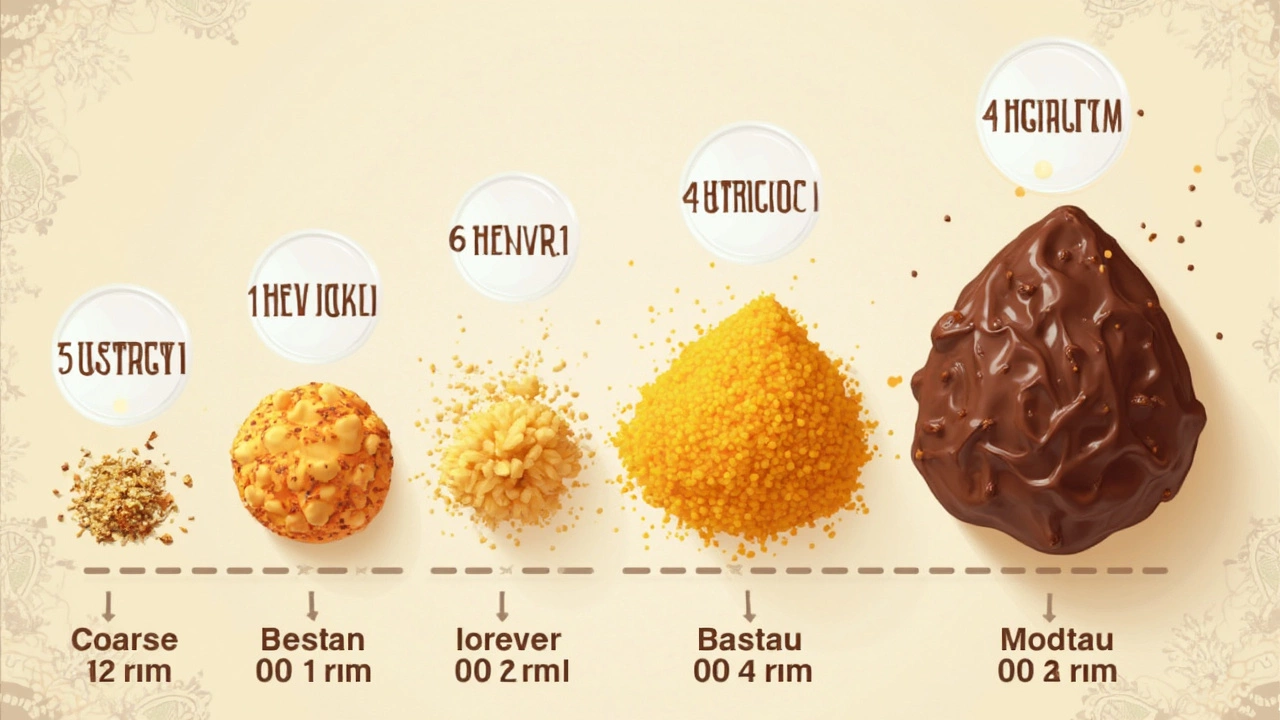
Ever wondered why some chocolate feels velvety smooth and some turns out gritty? Or why flour can make bread chewy or fluffy, just by changing its texture? The answer often comes down to a tiny unit you see on food tech labels: μm.
μm stands for micrometer—sometimes you'll hear it called a micron. It's tiny. One micrometer is just one-millionth of a meter. Try picturing a single hair from your head. That strand is about 70 μm wide. Imagine dividing that up into 70 slices, and each slice would be one micron thick. Now we're talking food science!
In food processing, this kind of measurement isn't just for scientists. It helps figure out how fine to grind cacao nibs, how smooth to blend nut pastes, or how consistent your flour should be for the perfect loaf. If you run a bakery, make plant milks, or craft beer at home, understanding μm gives you real control over taste and texture. Even big food factories obsess over these numbers because, at this scale, a few microns can mean the difference between success and failure.
- What Does μm Actually Mean?
- Why μm Matters in Food Processing
- Real-World Examples: Flour, Chocolate, and More
- How to Measure μm in Food Production
- Tips for Getting the Right Particle Size
- Common Mistakes People Make with μm
What Does μm Actually Mean?
Let’s break down the mystery behind μm. This little symbol stands for "micrometer"—or "micron," if you want to sound cool at a dinner party. One μm is one-millionth of a meter. You could line up a million micrometers end to end and only cover a single meter. In other words, we’re talking tiny—way smaller than anything you can really see without a microscope.
Here’s where that matters: μm is the go-to unit when you're talking about particle size in food processing. For folks working with anything ground, blended, filtered, or even puréed, it helps to know exactly how fine those particles are.
To give you some perspective:
- A human hair is about 70 μm wide.
- Wheat flour for bread usually lands between 20–40 μm.
- Milk fat globules typically measure 0.2 to 15 μm.
- Table salt grains are roughly 200 μm across.
When someone says an ingredient is “10 microns,” that means 10 μm, which is invisible to the naked eye but still has a huge effect on texture. In food processing, measurements this precise matter because small shifts in particle size can totally change how a product looks, feels, and even tastes.
Here’s a quick comparison table to show how μm stacks up against other common units:
| Unit Name | Symbol | Equivalent in μm |
|---|---|---|
| Millimeter | mm | 1,000 μm |
| Micrometer (Micron) | μm | 1 μm |
| Nanometer | nm | 0.001 μm |
So if you ever run into μm on a label, manual, or recipe, now you know it’s talking about incredibly tiny measurements that have a big role in food processing and quality control. Next time someone throws around "micron size," you're ready to join the conversation.
Why μm Matters in Food Processing
It’s easy to ignore tiny numbers like μm when you’re rushing around a kitchen or factory. But this small unit makes a massive difference in nearly every part of food processing. Why? Because particle size affects how food feels, looks, and even tastes.
Let’s talk about flour first. Commercial all-purpose flour is usually ground to about 100-120 μm. Bread flour is a little coarser, ranging up to 140 μm. Now, compare that to a really fine cake flour—it can be below 90 μm. These differences are why cake feels soft while rustic bread keeps that chewy bite. Even a small shift—say, just 10 μm—can change how liquids are absorbed, how dough rises, and how the finished crust turns out.
Ever made peanut butter that separates or feels sandy? That’s a particle size issue. Industrial peanut butter gets particles down to around 10-20 μm, which is why it’s so silky. Chunky kinds stop the grind earlier—sometimes at 50 μm or more—to leave those satisfying bits.
| Food Product | Typical Particle Size (μm) |
|---|---|
| White Flour | 90-120 |
| Chocolate (finished) | 15-30 |
| Peanut Butter | 10-50 |
| Coffee Grounds (espresso) | 250-500 |
Chocolate is another place where μm make or break quality. For that smooth, melt-in-your-mouth taste, chocolate makers refine their batch until particles are below 30 μm. If you leave them bigger, you’ll taste that roughness—not a good look for premium brands.
μm also matters in drinks. When you filter juice or beer, you use mesh screens with certain microns printed right on them. A 5 μm filter will catch almost all yeast and sediments, leaving the drink clear. Pick a 100 μm filter, and you’ll just remove the big stuff.
So, whether you’re baking, blending, or brewing, knowing your numbers in μm helps you get the texture and consistency you want every time.
Real-World Examples: Flour, Chocolate, and More
When you talk about particle size in food, μm (micron) makes a huge difference you can taste and feel. Take flour, for example. Regular wheat flour you buy at the store normally lands in the 100 to 150 μm range. Cake flour, which is softer and makes fluffier cakes, is typically ground much finer — around 50 to 80 μm. This is why biscuits made with cake flour practically melt in your mouth.
Switch over to chocolate. Chocolate makers obsess about particle size because it changes everything about what you feel on your tongue. For that smooth, melt-in-your-mouth experience, the mix (called chocolate liquor) gets refined down to 15 to 25 μm. Anything coarser and your chocolate feels gritty — nobody wants that from a fancy bar!
Here's a quick table that gives you an idea of typical μm ranges for common foods:
| Food Product | Typical Particle Size (μm) |
|---|---|
| All-purpose flour | 100-150 |
| Cake flour | 50-80 |
| Chocolate (finished/liquor) | 15-25 |
| Instant coffee granules | 200-400 |
| Milk powder | 10-40 |
Nut butters are another spot where μm comes into play. Ever notice how homemade peanut butter can be kinda chunky? Industrial nut butters are ground much finer (usually below 20 μm), so they're super smooth and don't separate as easily. It’s the reason your kids can spread store-bought peanut butter on bread with zero fuss.
In drinks, too, μm matters. A lot of the 'mouthfeel' in plant-based milks (like oat or almond) is tuned by blending solids just right, often aiming for an average particle size under 40 μm. This way, you get a creamy texture and nothing weird clumping up at the bottom of your glass.
The right μm size can be the secret behind food that looks, feels, and tastes exactly how you want it. Whether you're baking, blending, or brewing, knowing these numbers makes a difference you can actually notice at the table.

How to Measure μm in Food Production
If you’re dealing with food textures or need exact grind sizes, knowing how to measure μm is a game-changer. You can’t just eyeball a micron—these particles are way too tiny for that. Instead, food processing uses special tools and reliable methods to size things up.
The most common way pros check particle size is with a tool called a laser diffraction analyzer. You feed a tiny sample into the machine, a laser shoots through it, and the analyzer spits out a readout of the particle sizes in μm. Fancy? Yes, but also used all the time in flour mills, chocolate factories, and spice plants. For less high-tech setups, people sometimes use a set of stacked sieves, each with smaller and smaller holes (measured in microns, of course). If you’ve seen big sieve towers in a bakery, that’s what’s going on.
Here’s a rundown of typical ways particle size is measured in food processing:
- Laser diffraction: Fast, pretty accurate, and great for both big and tiny particles. Some chocolate makers swear by it.
- Sieve analysis: Cheap and old-school, but it only works down to about 20 μm. Anything smaller and even flour drifts through.
- Microscopy: A strong microscope can let you see individual particles and even snap a photo, but counting them one by one is slow.
- Dynamic image analysis: This machine takes rapid-fire pictures and tells you the average particle size. It’s popular in high-volume operations.
If you need a sense of what these sizes mean in real life, check out common grind sizes (in microns) for key foods:
| Food Product | Typical Size (μm) |
|---|---|
| Wheat flour | 90-120 |
| Espresso coffee | 250-500 |
| Chocolate liquor | 15-20 |
| Ground pepper | 300-400 |
If you’re running a small kitchen or home setup and can’t afford fancy gear, some labs will measure particle size for you. Or you can use a simple feel test in a pinch—rub a little flour between your fingers—the smoother it feels, the smaller the average μm. But for real accuracy in food processing, nothing beats the machines that do the sizing for you.
Tips for Getting the Right Particle Size
Nailing the right particle size isn’t just about punching numbers into a food processing machine. It’s about matching texture with purpose. For example, chocolate needs to hover around 20 μm for that silky mouthfeel, while most wheat flours work best between 100 to 150 μm, depending on what you’re baking. Going too fine or too coarse can totally change the final product.
- Know your target μm: Always check what particle size works best for your recipe. Chocolate pros, for instance, swear by the 18-22 μm range to avoid any grit. Bread bakers often want flour between 90 and 150 μm for good crumb without a sandy texture.
- Use the right tool: Burr grinders, impact mills, and roller mills each create different micron ranges. A burr grinder is great for coffee and spices but isn’t ideal for flour or chocolate. For super fine results, some kitchens even use wet mills or micronizing devices.
- Test and tweak: Don’t just trust the numbers. Rub the processed product between your fingers or taste it. If it feels gritty, it’s probably over 25-30 μm. If it’s powdery, maybe you’ve gone too far. Adjust grinding time and equipment speed as needed.
- Sieve it out: Sieves and mesh screens are simple but effective. They let you sort out big particles. For flour, using a mesh with holes around 100 μm makes sure only the right stuff goes into your dough.
- Don’t forget moisture: Wet materials clump up and skew the μm reading. If you’re measuring particle size, make sure the sample isn’t damp. Dry the material first for an accurate read.
Curious how small differences actually look? Here’s a quick visual reference:
| Product | Typical Particle Size (μm) |
|---|---|
| White Flour | 100-150 |
| Powdered Sugar | 10-50 |
| Rolled Oats | 500-1000 |
| Chocolate | 18-22 |
Accurate μm measurement in food processing is all about control. Start with small batches, and dial in on what works best for your product. If you get the micron size wrong, you’ll notice—even if your customers can’t name the reason why their favorite treat just feels a bit off.
Common Mistakes People Make with μm
Even experienced folks in food processing trip up on μm, or micron, measurements. These mistakes can mess with both quality and efficiency, so let’s break down what usually goes wrong.
The first big issue? People often confuse millimeters (mm) and micrometers (μm). They look similar on paper, but 1 mm equals 1,000 μm. That means confusing the two could make your flour 1,000 times coarser than planned—nobody wants to chew on gravelly bread or lumpy chocolate. Always double-check the units on your gear labels and recipes.
Another slip-up is ignoring particle size distribution. Some assume that hitting a target μm number is enough, but it’s not just about the average size; it’s also how much the sizes vary. If a batch of flour is 20 μm on average but half the particles are still at 100 μm, your dough might end up uneven and the texture unpredictable.
Cleanliness is another underrated problem. Even tiny bits of old product stuck in your grinder or mill can throw off the particle size by several microns. This matters for things like milk powders or cocoa, where smoothness is everything.
- Not recalibrating particle measurement instruments regularly. Over time, sieves and laser particle sizers drift, so readings get less reliable.
- Forgetting that humidity matters. Moisture can cause clumping, which produces false readings and affects food processing results.
- Assuming all foods require the same micron range. Each food—chocolate, flour, or spice blends—needs its own optimal distribution.
Check out this quick comparison of common food particle sizes:
| Food Product | Typical Size Range (μm) |
|---|---|
| Flour (cake) | 20 – 34 μm |
| Chocolate (smooth) | 15 – 30 μm |
| Instant Coffee | 200 – 500 μm |
| Sugar (powdered) | 10 – 40 μm |
If you keep these common μm slip-ups in check, you’ve got a huge edge for making everything from bread to chocolate reliably good—and maybe saving yourself from a few kitchen headaches, too.




